Havana Day #3 Visiting The Sights
What better place to start than a rum factory and museum!
Did You Know? -
The Bocoy Rum Factory on Avenida Máximo Gómez in Havana (FCA De Ron Bocoy) was established in 1878 to produce both Ron Bocoy and also the Legendario brand. The word Bocoy is a Cuban unit of capacity from the 19th century. In Havana the bocoy was reportedly especially used for honey, = 6 barils, approximately 136 liters, and weighed 12 arrobas, approximately 138 kilograms.

Come on in!!

Checkout the swans

Good drinks!

Old tapestries date back 100 years

Museum of the older equipment once used

We get an explanation

Perfect English

If Fidel likes it then you must like it.... It's the law

Cuban heroes

Labels over the years

Time for a drink!

A quick stop... Rum for breakfast??
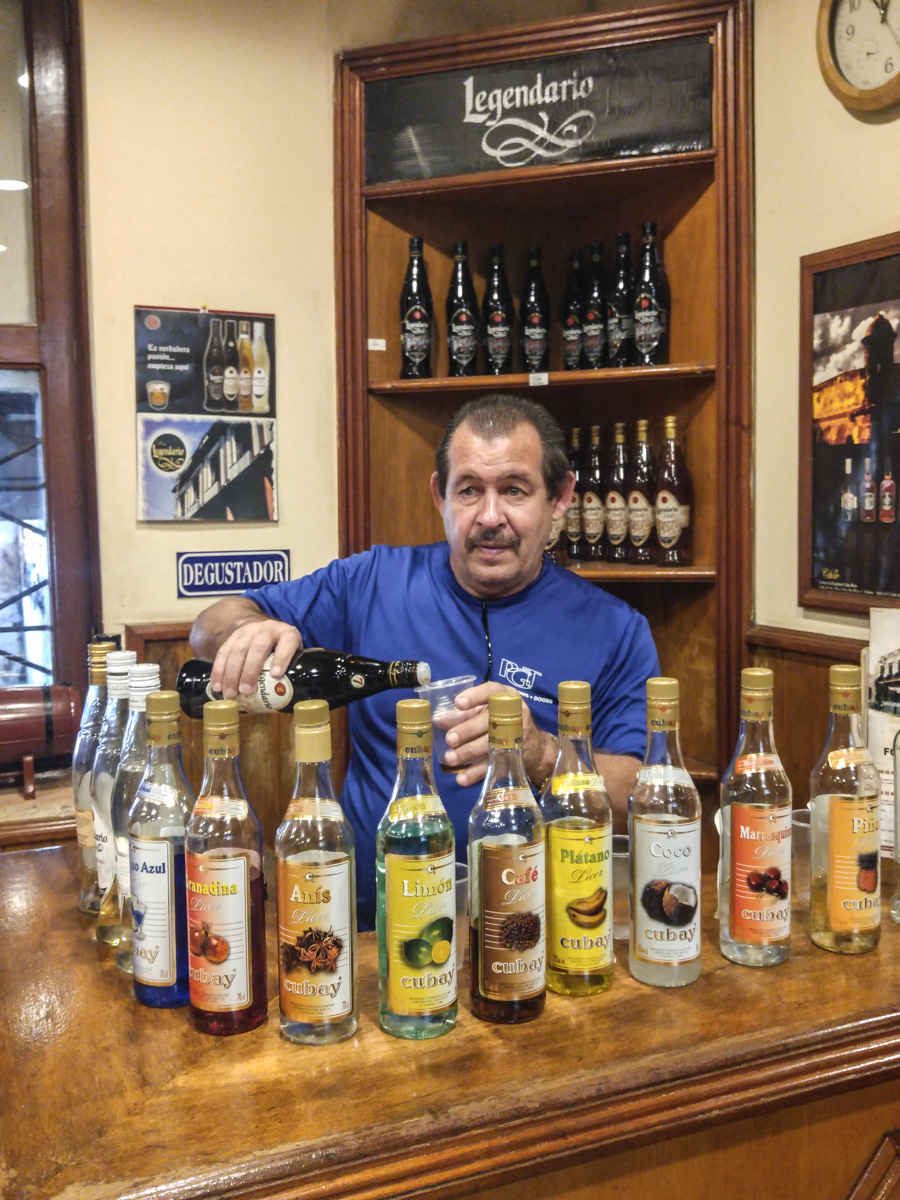
Many flavors to choose from

One of each... please!

It might take two of us to finish them all off


Did You Know? - The basilica and the monastery of San Francisco de Asis were built in Havana, Cuba at the end of the sixteenth century (1580–91) as the home of the Franciscan community in Havana. The basilica was altered in 1730.

Across the open area to the basilica

Built in 1750's

Oil painting from the 1750's
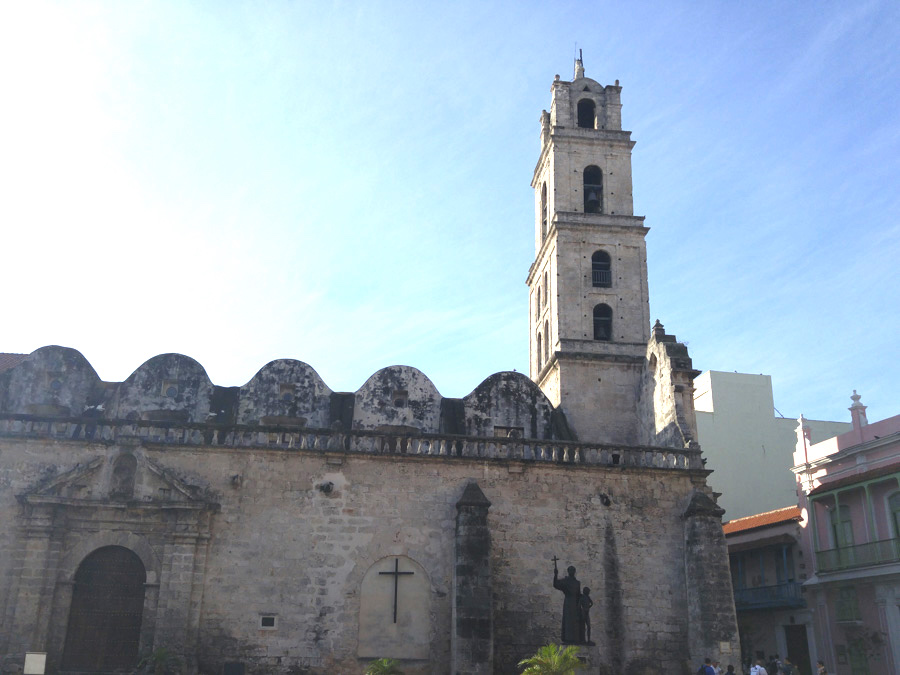
Looks pretty good for being 250 years old!

Still an active church

Located on the Plaza de San Franscisco

We are off to walk the Plaza de San Fransisco

On the Plaza de San Francisco in Havana directly across
from the church
Did You Know? - Plaza de San Francisco de Asís Square was built facing Havana port in the 16th century, when Spanish galleons would stop here on their way through the Indies to Spain.
Throughout the first few decades of the 15th century the square had a market and, in 1608, a church was built there.

Now for a quick walk to the bronze


"Watch your hands there lady!!"

Greeting the visitors
Did You Know? - Palacio del Marqués de San Felipe y Santiago de Bejucal Hotel is rated five stars! History and modernity come together in this building that at the end of XVIII century belonged to Don Sebastián de Peñalver. At the beginning of the XIX century the property changed hands to the successors of the IV the Marquees of San Felipe and Santiago. The minimalistic interior blends perfectly with the baroque style of its façade. The Hotel Marqués de San Felipe y Santiago de Bejucal is the first Habaguanex Hotel on San Francisco de Asís Square.
The hotel benefits from a privileged location, nearby the Convent of San Francisco de Asís, home to one of Havana's best concert halls, dedicated to chamber and choral music. In the vicinity you find the Carmen Montilla gallery, the elegant Café del Oriente, the business center of Old Havana (Lonja del Comercio), the popular Museum of Chocolate and the Cuban Contemporary Ceramics Museum.
From the roof top terrace on the sixth floor of the hotel, visitors can use a telescope to take in the splendor of old Havana. San Francisco de Asís Square, with it's many pigeons and charming Lions Fountain, carved out of marble from Carrara by the Italian artist Giuseppe Gaggini, also treasures the statue of El Caballero de Paris, one of Havana's most cherished personages.

TYhe streets are quite narrow and no auto traffic to be seen

Statue of "The Conversation" - The beautiful contemporary bronze sculpture titled 'La Conversación' looks out over Plaza San Francisco de Asís from atop a marble plinth in front of the entrance to the Lonja del Comercio. Made by French artist Etienne and donated by Vittorio Perrotta to the City in September 2012, it represents the need for dialogue in contemporary society.


The Money Exchange on the plaza
Did You Know? - Very beautiful place, it was nice to hang out and look locals and tourist and admire old cars. By the plaza there is also money exchange place called Casa de Cambio. Don't be blinded by the secure looking building - it looks a lot like a bank and even has a security guard on the door, who lets one by one someone in as another customer leaves.

Beautiful old building line the plaza

Senior citizen photo content announcement
Did You Know? - The Center for Cultural Management, the House of Poetry and the Hispano-American Center for Culture of the Office of the City Historian of Havana invite senior citizens interested in literature and photography to participate in the contest Ciudad Bella, Havana, which will be awarded once a year in October.

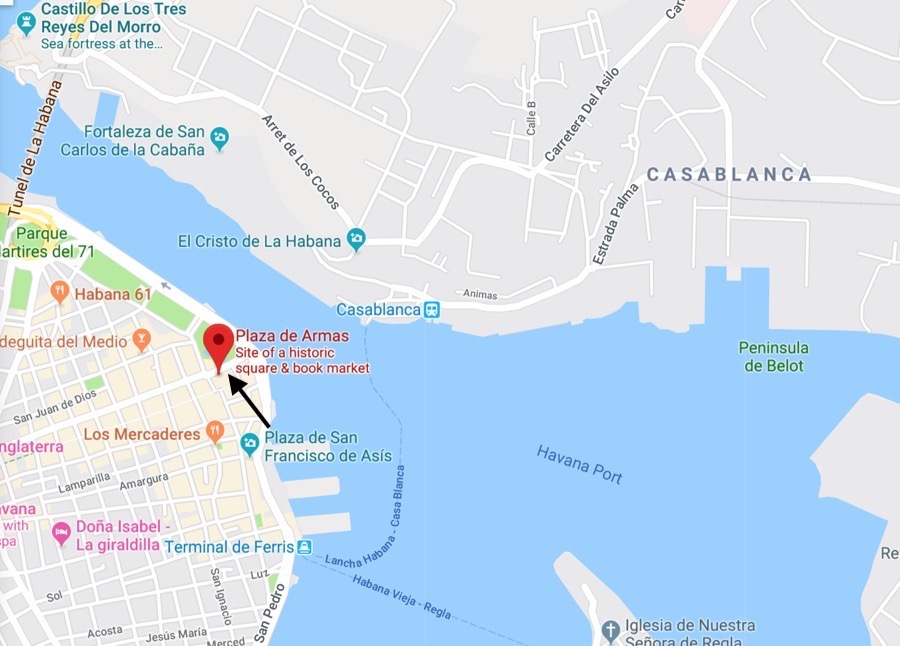

Did You Know? - The Plaza de Armas (literally Weapons Square, but better translated as Parade Square or parade ground) is the name for all of the Colombian main squares. In the central region of Mexico this space is known as El Zócalo and in Central America as Parque Central (Central Park). While some large cities have both a Plaza de Armas and a Plaza Mayor, in most cities those are two names for the same place.
Most cities constructed by the Spanish conquistadores were designed in a standard military fashion, based on a grid pattern taken from the Roman castrum, of which one of the blocks would be left vacant to form the Plaza de Armas. It is often surrounded by governmental buildings, churches, and other structures of cultural or political significance. The name derives from the fact that this would be a refuge in case of an attack upon the city, from which arms would be supplied to the defenders.

Beautiful gardens occupy the center of the plaza

Time for a stroll around the square

Dates to the early 1800's

Bookstores abound

A dry spot for celebrations

Our bus awaits while we continue to explore the Plaza De Armas

Additional bookstores

Stamped into the iron works all around the plaza

Carlos Manuel de Céspedes

In the center of Plaza de Armas, ringed by royal palms, is a marble statue of Carlos Manuel de Céspedes, the man who set Cuba on the road to independence in 1868.

Honored by all
Did You Know? - Carlos Manuel de Céspedes del Castillo was a Cuban revolutionary hero. Cespedes, who was a plantation owner in Cuba, freed his slaves and made the declaration of Cuban independence in 1868 which started the Ten Years' War, which ultimately led to Cuban independence.

The central garden in the plaza is well taken care of by the city

Our guide takes us through the
Palacio de los Capitanes Generales
Did You Know? - The Palacio de los Capitanes Generales is the former official residence of the governors (Captains General) of Havana, Cuba. Located on the eastern side of the Plaza de Armas in Old Havana it is home to the Museum of the City of Havana (Museo de la Ciudad). It houses exhibitions of art and historical artefacts and many of the rooms are preserved with their original Colonial decoration.
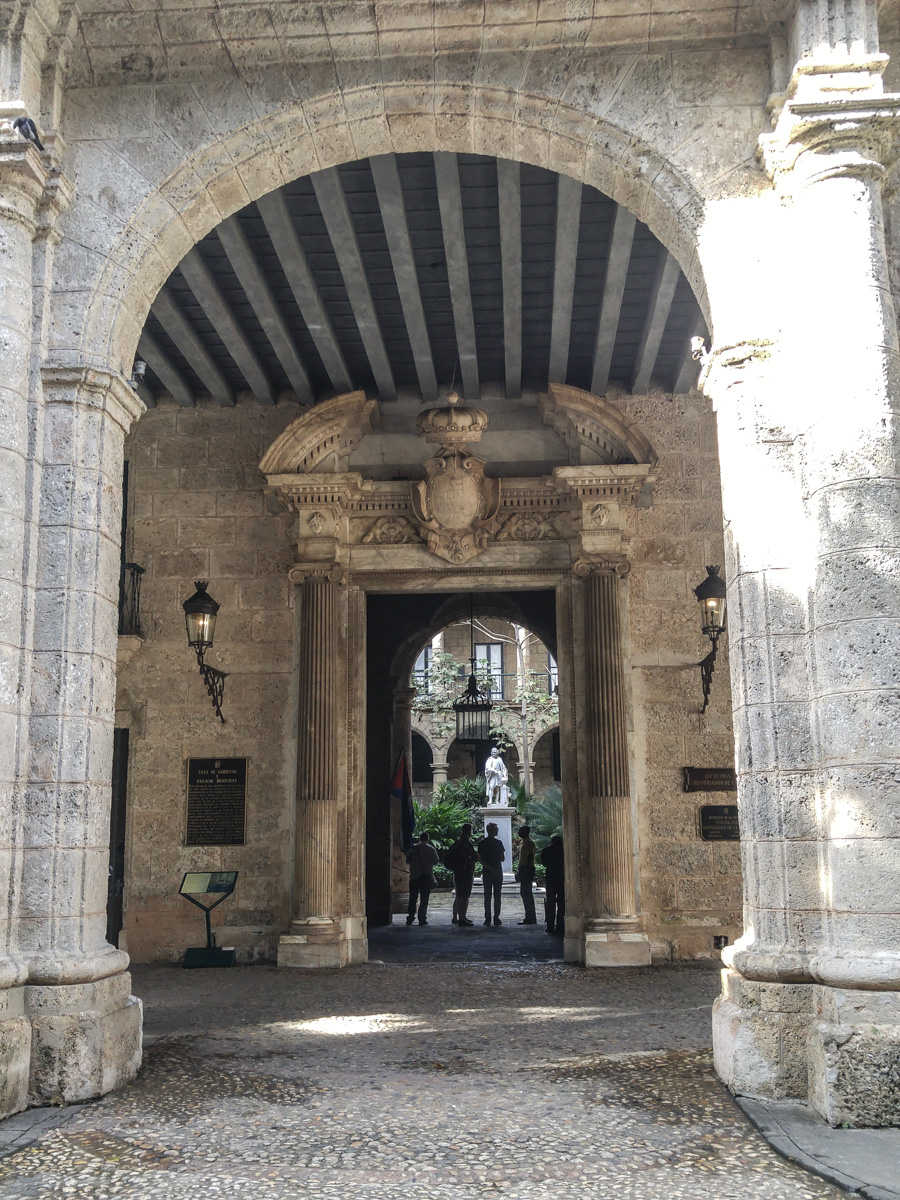
Through the columns into the courtyard. Read more...

Limestone arches support the balcony

The municipal authorities moved elsewhere in 1967 and in 1968 the palace became the City Museum.

The Palacio de los Capitanes Generales is the former official residence of the governors of Havana, Cuba. Located on the eastern side of the Plaza de Armas in Old Havana it is home to the Museum of the City of Havana.

Statue to the revolution

Hige stone stairways on two sides of the building

It occupies a city block

The left-hand side of the plaza

It's bigger than it looks!

We continue exploring the plaza and its tributaries

One can always find a dining establishment

The streets have gone un-paved for 100's of years

The old and the new stand together

In costume

The cats never go hungry around here!

Everyone is watching (Mural de Mercaderes by Andrés Carrillo) - This approx 300 square meters mosaic mural on Mercaderes Street right across the Marqués de Arcos mansion is made up of 52 panels that depict 67 outstanding figures in the history and the arts in Cuba....
Did You Know? - This approx 300m2 mosaic mural on Mercaderes Street right across the Marqués de Arcos mansion is made up of 52 panels that depict 67 outstanding figures in the history and the arts in Cuba. The artist of the mural, Andrés Carrillo, used a novel material in Cuba that includes natural rock soaked in acrylic resin to make the small tiles. From four basic colors (brown, coral rose, black and beige), he obtained 13 shades. Many people participated in this work of art, including architect Jaime Rodríguez, sculptor Nicolás Ramos Guiardinú and students from the San Alejandro Art Academy.
 Lots of details
Lots of details

Come on in!

The walk continues...magnificent wooden doors in many of the old buildings

At one time, this was a post office...It is a mail drop!

We follow the guides


Did You Know? - The last of the main squares to be laid out during colonial times, Cathedral Plaza is perhaps its most intimate square and definitely one of Old Havana's most beautiful spots. Originally, it was a swamp area. However, the square was drained and a cistern built in 1587 as the main conduit of the Zanja Real—the city's first aqueduct, constructed between 1565 and 1592—to supply ship docked along the waterfront (which at the time abutted what is now Calle Tacón. The first rudimentary plaza—named Plazuela de la Ciénaga (Swamp Square) because of its muddy terrain—was laid out.
It gained its modern look in the 18th century, when a paved plaza was laid out. It soon became one of the city's most important squares as wealthy families moved in and began building mansions embellished with porticoes, per Spanish dictate, to provide shade and shelter from tropical rainstorms. A church—the Iglesia de la Compañía de Jesús—was completed in 1777 and consecrated as the city's cathedral in 1793, when the square was renamed Plaza de la Catedral. With its curves and flourishes above doors and windows, the Catedral de La Habana is Havana's finest example of 18th-century Cuban baroque. Baroque was late to arrive in Cuba, and the porous nature of the locally quarried limestone, which was embedded with coral fossils and seashells, handicapped its ornate style. Even so, Cuban writer Alejo Carpentier described the cathedral as 'music made into stone'.
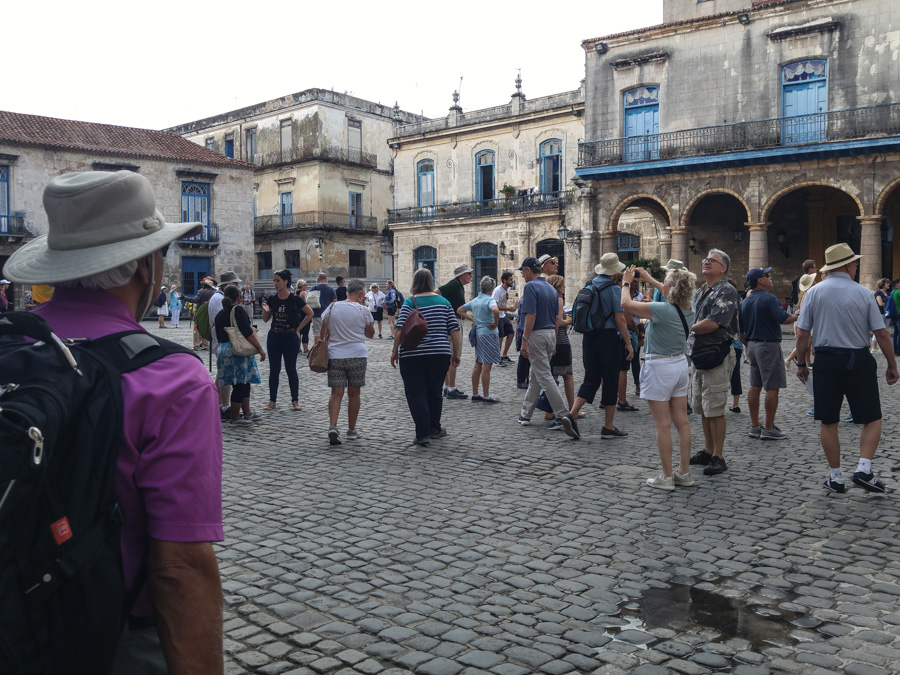
Pictures being taken from every angle possible!

La Catedral de la Virgen María de la Concepción Inmaculada de La Habana
Did You Know? - Havana Cathedral is one of eleven Catholic cathedrals on the island. It is located in the Plaza de la Catedral on Calle Empedrado, between San Ignacio y Mercaderes, Habana Vieja. The thirty by forty nine meter rectangular church serves as the seat of the Roman Catholic Archdiocese of San Cristobal de la Habana.

Keeping neighbors in their places!

Still quite active
Did You Know? - The largest missionary group in Havana was the Society of Jesus. After extensive petitioning and the purchase of a piece of land in the Plaza by Diego Evelino Hurtado de Compostela, Bishop of Santiago de Cuba, a permit was granted. The cathedral is set in the former Plaza de La Ciénaga. In 1727 plans to build a church, convent and collegium were approved and the project began to take form. The plaza is located on the site of a swamp that was drained and used as a naval dockyard before the cathedral was built. The Jesuits began construction of the cathedral in 1748 on the site of an earlier church and it was completed in 1777, well after King Carlos III expelled the Jesuits from the island in 1767. The cathedral once held remains of Christopher Columbus
In 1796, after the Peace of Basel was signed and Spain ceded most of Hispaniola to France, the remains of Columbus were moved and laid to rest in the Havana Cathedral's Altar of the Gospel. The gravestone read: Oh Remains and Image of Great Columbus, Be Preserved One Thousand Years in the Funerary Urn. The remains were returned to Spain in 1898 after the Cuban War of Independence.

The organist has a super view of the entire room

Artwork abounds around the church

Christopher Columbus rested here until 1898

The cark versus light is stark on a bright day

Famous explorers have their remains in the church


The stained glass cast amazing colors on the marble

Street signs are mounted to the buildings... Names only

Around back a major boulevard exists

...and the old cars!

Back on the bus...heading to the ship
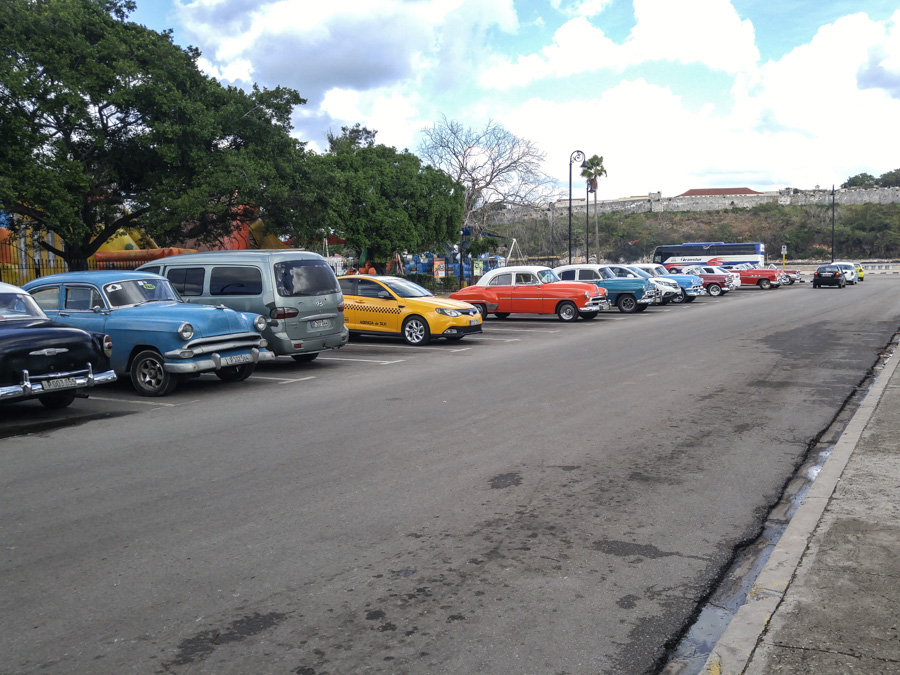
Can you identify the cars?

At the mouth of Havana Harbor

One more fort to see

A curiosity today ... A might fortress 100 years ago

Yes... There are some new cars

Upscale bar & nightclub since 2003 offering late hours & live music ranging from salsa to reggaeton

The Hotel Capri
Did You Know? - In 1955, President Batista enacted Hotel Law 2074, offering tax incentives, government loans and casino licenses to anyone wishing to build hotels in excess of $1,000,000 or nightclubs for $200,000 in Havana. This bill brought Meyer Lansky and his "associates" in the mafia flooding to the city to take advantage.
The Hotel Capri de Havana was one of the first to be built. Located on Calle 21, 1 Mp. 8 Vedado, only two blocks from the Hotel Nacional, it opened in November 1957. With its 250 rooms, the nineteen-story structure was one of the largest hotel/casinos in Havana during its heyday. It boasted a swimming pool on the roof.
Owned by mobster Santo Trafficante, Jr. of Tampa, Florida, the hotel/casino was operated by Nicholas Di Costanzo, racketeer Charles Turin (aliases: Charles Tourine, Charley "The Blade"), and Santino Masselli of the Bronx NY(aliases:"Sonny the Butcher"). After it opened, George Raft was hired to be the public front for the hotel's club during his gangster days in Cuba. It was believed that he owned a considerable interest in the club.
The hotel was designed by architect Jose Canaves and owned by the Canaves family. The hotel, along with its famous casino, was leased to American hotelier, "Skip" Shephard. The Hotel Capri was nationalized by the Cuban government in October 1960, and the casino was closed.
The hotel was known as the Hotel Horizontes Capri in the 1990s, before it closed in 2003. It reopened in January 2014, following major renovations managed by the Spanish NH Hotel Group as the Hotel NH Capri La Habana.
In 2017 the hotel was exposed as the site of multiple alleged bizarre incidents. Reports of piercing, high-pitched noises and inexplicable ailments pointed to someone deliberately targeting the U.S. government's intelligence network.

Sit a spell... Have a drink

Time for a smoke!

Damn... It was actually pretty good!

All smiles

Enhale down to your toes

Oh oh... Smoke rings?????

An interesting decor

and another bar

Back to the ship

One last look a Havana and we set sail in a few hours for a day at sea!
